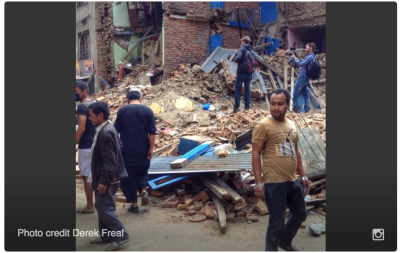With social media, we are all journalists. Modern technology gives us up-to-the-minute ability to see how drunk Stacy becomes — via her Snapchat story. At the same time, we can be briefed on wars on the other side of the world, or efforts to deliver aid to victims of an earthquake or the ousting of a dictator with a few taps on our screens. Someone in Syria is holding a smartphone, a device that can have a further and more powerful range than any combat weapon.
As more people around the world have gained access to the Internet, especially on hand-held, wireless devices, we have gained access to a growing number of first-hand accounts of the world’s news. Charlie Beckett, a leading media scholar and analyst at the London School of Economics, says that “networked” journalism” uses new technologies to include the citizen in every aspect of news-gathering, production and publication. For example, networked journalism “is the use of camera phones by citizens, capturing news as it happens and sending it to news organisations around the world.” But as we gain access to a flood of reports by “lay-journalists,” we don’t always have the luxury of trusting that they are accurate.
Because tools like Photoshop are so widely used, the integrity of nearly all images is in something of a grey area. We have to use more scrutiny when presented with an image whose content or origin seems questionable. “Established” news organizations generally have an interest in ensuring that their reports are accurate, as they will lose trust from their viewers and readers if they don’t maintain a reputation for verifying their sources. In contrast, a Twitter account operated by an unknown human entity is not quite as concerned about having a sterling reputation — for many outlets, likes and views can trump accuracy.
For instance, this photo of sharks in a mall is, unfortunately, not real.
Thankfully, networked journalism can still be a source of accurate, useful information, as well-known news outlets have taken to vetting the truthfulness of “citizen journalism.” Outlets like The Wall Street Journal have designated teams who verify the accuracy of open-sourced images and information, like those in this feed:
As we are brought closer to the source of news through networked journalism, we become more connected with otherwise distant events. For example, the Nepal earthquake in April was widely covered and gained broad international awareness, as well as crowd-sourced efforts to raise relief funds. When we see news that inspires empathy, we are more moved to react to it. People in the United States are brought much closer to a tragedy on the other side of the world when we have photos posted by eye-witnesses as the tragedy is occurring. In this case, Twitter feeds were rife with photos of the earthquake’s destruction in real time.
The massive potential in networked journalism can be seen in the Egyptian government’s efforts to curb it in the wake of the 2011 protests against the Mubarak administration. As protesters took photos and communicated abuses of Egyptian security forces to gain attention and support, the government suspended all Internet and cell service in the country. Due to backlash, the government eventually brought the Internet back up for fear of inspiring additional dissent. Protesters in Egypt and throughout the Middle East during the Arab Spring uprisings made use of phone cameras to bring the world live updates of the revolutions. We were brought closer to the upheaval by the humanizing, first-person style of the reports.
Networked journalism is essential in keeping us up-to-date on Syria, as one of the most violent and turbulent places in the world is embattled by rebel groups, the regime of President Bashar al-Assad, ISIS and foreign militaries. While Syria now receives a large amount of international coverage on its brutal civil war and refugee crisis, Westerners were likely unable to locate it on a map five years ago. The first-hand, online accounts of people on the ground in Syria’s civil war play a significant role in creating that coverage. Just as quickly as we are updated on the trending developments of Stacy’s insane party, we can receive breaking news about how out of control issues in Syria have become. This interactive map shows first-hand reports of violence in Syria, with attached video of each individual incident.
We can see the massive impact that personalization of news has on viewers in the iconic and gut-wrenching photo of a Syrian child who died while trying to reach Europe. Photos such as this one elicit engagement and create more of a link between the viewer and victim when they are undeniably clear and current. After the photo was circulated online, governments around the world demanded a response to the Syrian refugee crisis. When the distant crisis can be looked in the eye, we understand it more fully, and it gains urgency.
“Citizen journalism” has also had a far-reaching impact much closer to home. When security video taken of Michael Brown’s death was circulated on Internet last year, millions saw the event. Amateur cell phone cameras shot footage of the fatal encounter between Eric Garner and police. Before the age of networked journalism and camera phones, capturing this kind of footage was not possible. The personalization of the Michael Brown coverage in its raw, unedited nature incited a massive national response that we likely wouldn’t have seen without access to platforms that let us share footage on an immense scale. Only a few years ago, our first reaction to seeing police brutality would not be to take out our phone and film, but rather to run away.
As more and more people have the capacity to be journalists in regard to what they see around them, we become more connected to news around the world on an immersive, personal level. More access to means of reporting and reading media at a faster pace means that we become more informed and engaged. A more connected world creates mutual accountability. The same technology that lets us see Stacy’s shenanigans on Snapchat can deliver engaging, crucial and personalized accounts of the world’s most pressing stories.
My apologies to all those with the name Stacy — I used the name only for the sake of alliteration.



























































































































